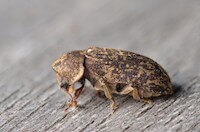WHAT DO Deathwatch BEETLES LOOK LIKE

Adult deathwatch beetles, Xestobium rufovillosum (Coleoptera: Anobiidae) are brown, hairy, and cylindrical as adults, with an odd shape to the plate covering the head (called the pronotum or prothorax). It is a small beetle, measuring around 5-9 mm in length. Deathwatch beetle larvae are small, pinkish-white grubs measuring up to 11mm in length. The male deathwatch beetle attracts its mate by bumping its head or jaws against wood, making a tapping noise. The noise, which attracts the females, is often only heard when the house is quiet since activity can scarethe beetles back into hiding. But once quiet, you just might hear that tapping sound. They derived their name from this behavior during olden times. People that were assigned to watch over the sick would hear the tapping since they kept the house quiet for the sick person under their care.
Female deathwatch beetles lay their eggs in holes and crevices in wood which the hatched larvae then feed on. The larval stage may last for between one and 13 years depending on the temperatures in the house. During every year of larval development, the larvae are actively tunnelling and boring through the wood. It’s only the larvae that live within the wood, and they emerge as adults leaving a 3-4 mm hole in the wood behind them.
Female deathwatch beetles lay their eggs in holes and crevices in wood which the hatched larvae then feed on. The larval stage may last for between one and 13 years depending on the temperatures in the house. During every year of larval development, the larvae are actively tunnelling and boring through the wood. It’s only the larvae that live within the wood, and they emerge as adults leaving a 3-4 mm hole in the wood behind them.